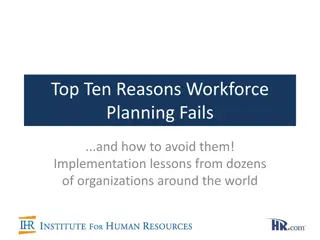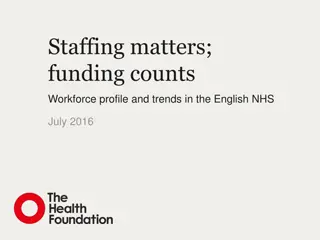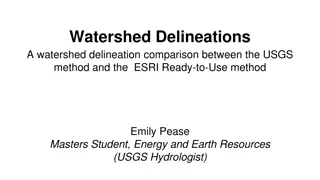USGS Workforce Planning Data Analysis
Utilize USGS Workforce Data Standards and Resources to access and analyze workforce demographics through the USGS Workforce Demographics Dashboard. Gather insights for strategic planning and decision-making.
Download Presentation

Please find below an Image/Link to download the presentation.
The content on the website is provided AS IS for your information and personal use only. It may not be sold, licensed, or shared on other websites without obtaining consent from the author.If you encounter any issues during the download, it is possible that the publisher has removed the file from their server.
You are allowed to download the files provided on this website for personal or commercial use, subject to the condition that they are used lawfully. All files are the property of their respective owners.
The content on the website is provided AS IS for your information and personal use only. It may not be sold, licensed, or shared on other websites without obtaining consent from the author.
E N D
Presentation Transcript
Toxicity of fluoride Dr. Rihab Abdul Hussein Ali B.D.S , M.Sc. , PhD.
For more than 6 decades, fluoride has been the first line of defense against caries. After years of laboratory research, animal experiments, and clinical trials, researchers now have a good idea how fluoride works to prevent tooth decay. They have also learned more about how fluoride interferes with a number of host biological processes. Clinicians should be aware of the total daily fluoride intake to which their patients are exposed. Once the background exposure is known, side effects can be minimized while ensuring maximum anti-caries benefit is attained Fluoride toxicity: refers to excess fluoride ingestion involving acute or chronic form.
Sources of excess systemic fluoride Water, beverages, and food: Fluoride is the thirteenth most abundance element in the earth s crust and occurs naturally in ocean water at levels of about 1.3 ppm , up to15 ppm in ground water, and up to 2,000 ppm in soil. Certain foods contain more fluoride than others. Dark tea, for example, is enriched in fluoride and can range between 3 and 6 ppm.
Accidental fluoridation overfeeds have resulted in acute fluoride poisoning, and could result in death in addition there have been accidental exposures of the concentrated fluoridation chemicals that have resulted in severe acute fluoride chemical burns and life-threatening squeal. In past years, skin burns of this type were common for many water engineers who emptied drums of fluoride agents into the hoppers feeding water supplies.
Medicines: In addition to fluoride supplements, many common pharmaceuticals used in medicine are fluorinated. The more common ones include Celebrex, Cipro, Diflucan, Prozac, Dalmane, Lipitor, and nearly all of the halogenated general anesthetics. Depending on the molecular formula, these drugs contain from 3 17% fluorine by weight. Some have been shown to lose free fluoride from defluorination by cytochrome P450 enzymes.
Pollution: Increased fluoride intake can occur from inhaling fluoride-polluted air. The highest fluoride levels found in air have been documented in area where coal is burned extensively for industrial power generation. In some areas, where dental fluorosis has been documented to be quite severe and skeletal fluorosis has been observed, the concentration of fluoride in ambient can be as high as 11 g/m3. (1 PPM = 1,000 microgram per meter cubed. Similarly, 1 microgram per meter cubed = 0.001 PPM).
Acute toxicityclinical signs, diagnosis, treatment Acute toxicity occurs due to single ingestion of a large dose of fluoride at one time. The severity depends on the amount and form of fluoride ingested, age and weight of person as well as the rate of absorption. The FDA and occupational safety health legislation carefully regulates the handling of fluorides in industry and in the marketplace. Commercial dental fluoride products and professional practices can be toxic and even lethal when used inappropriately
Every parent (and health care professional) should be aware of the potential emergency that could result from an ingestion of a sizable amount of fluoride. The investigators have recommended a probable toxic dose (PTD) standard based on body weight as a more practical approach to making treatment decisions. They defined the probably toxic dose (PTD) as: the minimum dose that could cause toxic signs and symptoms, including death, and that should trigger immediate therapeutic intervention and hospitalization and that dose with it, the urgency for first aid and more definitive emergency treatment can be determined rapidly.
The PTD approach, first reported bases the level and urgency of treatment on the number of multiples of 5 mg/kg of fluoride ingested. For example the sources of a probably toxic dose in low weight 28-month toddler weighing 10 kg (22 pounds) are listed in Table below. This table can be used for quickly judging whether or not toddlers or children weighing more than 10 kg have consumed a toxic dose of fluoride.
Some sources of fluoride poisoning- A guide to probable toxic doses for a small toddler
Excessive exposure to fluoride results in four general reactions: (1) when a concentrated fluoride salt contacts moist skin or mucous membrane, hydrofluoric acid forms, causing a chemical burn (ulceration and necrosis can occur). (2) inhibition of enzyme systems. (3) binding calcium needed for nerve action. (4) hyperkalemia (excessive amount of potassium in the bloodstream) contributing to cardiotoxicity (damage to the heart muscle).
Following excessive ingestion of fluoride, nausea and vomiting can occur. The vomiting is usually caused by the formation of hydrofluoric acid in the acid environment of the stomach, causing damage to the lining cells of the stomach wall. Local or general signs of muscle tetany (intermittent, prolonged spasms) ensue from a drop in blood calcium (hypocalcemia). Abdominal pain can accompany this effect. Finally, as the hypocalcemia and hyperkalemia intensify, the severity of the condition becomes ominous with the onset of the three C s that can indicate death (coma, convulsions, and cardiac arrhythmias (irregular heartbeat)).
Emergency treatment for fluoride over dose: If the amount ingested is less than 5 mg/kg, the office use of available calcium, aluminum, or magnesium products as first aid antidotes should suffice. If the amount is more than 5 mg/ kg, first aid measures should be efficiently applied followed by hospital observation for the need for further care. Finally, if the amount of fluoride ingested approaches or exceeds 15 mg/ kg, the immediate first aid treatment should be followed by a most urgent action to move the patient swiftly into a hospital emergency room where cardiac monitoring, electrolyte evaluation, and shock support are available. Ingestion of 15 mg/kg fluoride can be lethal.
The blood level of fluoride reaches its maximum from one half to 1 hour after the fluoride is ingested; by that time treatment could be too late. Despite all precautions, potential for signs and symptoms of acute fluoride toxicity could exist in dental office misuse of excess amounts of professionally applied topical fluoride. To be prepared for such an unlikely emergency, the professional staff should be trained to institute emergency procedures if necessary.
Actions are especially significant in treating fluoride poisoning (If the amount is more than 5 mg/ kg ): Induced vomiting is beneficial and often occurs spontaneously. When vomiting does occur, the majority of the ingested fluoride is often expelled. Protection of the stomach by binding fluoride with orally administered milk or, better yet, milk and eggs should be given, for two reasons: (1) As demulcents, they help protect the mucous membrane of the upper gastrointestinal tract from chemical burns.
(2) They provide the calcium that acts as a binder for the fluoride. Calcium hydroxide or an aluminum preparation can be ingested to accomplish the same purpose. Plenty of fluid, preferably milk, should be ingested to help dilute the fluoride compound in the stomach. Preferably, the patient should be taken directly to a hospital emergency room.
Urgent and decisive treatment is mandatory once the PTD of 15 mg/kg has been approached or exceeded. Once in a well equipped medical facility, several options are possible, such as gastric lavage (use of a fluid to wash fluoride out of the stomach), blood dialysis (diffusion of blood across a semipermeable membrane to remove the fluoride) or intravenous delivery of calcium gluconate to maintain blood calcium levels.
Every effort should be made to rid the body rapidly of the fluoride or to negate its toxicity before refractory (resistant to treatment) hyperkalemia and cardiac fibrillation (rapid, irregular contraction of muscle fibers in the heart) become a more serious problem than the fluoride intoxication. Generally, death from ingestion of excessive fluoride occurs within 4 hours; if the individual survives for 4 hours, the prognosis is guarded to good.
General factors affecting acute toxicity: Form of administration: Fluoride toxicity from solution type is greater because of rapid absorption. Age: Younger age is severely affected by fluoride toxicity. Rate of absorption is high when empty stomach. Type of fluoride ion as stannous fluoride is slightly more toxic than others.
Chronic Excessive Fluoride Exposure (toxicity): Non-dental clinical signs Excess fluoride ingestion can lead to joint pain and bone problems. This is a major problem in areas of endemic fluorosis. Dentists should be aware that administration of too much fluoride for home use may put the patient at risk for joint pain or bone problems.
The exceedingly high level of continual intake of fluoride for 10 to 20 years resulted in a severe skeletal fluorosis characterized by osteosclerosis (abnormal increase in thickness and density of bone), calcification of the tendons, and the appearance of multiple exostoses (bony growths that arise from the bone s surface) and often accompanying osteoporosis, osteomalacia, or osteopenia. Other factors that increase the severity of skeletal fluorosis are high temperatures with a concomitant increase in drinking episodes, an elevated intake of fluoride in food, nutritional diseases (low vitamin D and calcium diets).
Briefly the severity of toxicity depends on: 1- The duration of fluoride intake. 2- Age of individuals. 3- Total amount of fluoride ingested. 4- Concentration of fluoride. If a dentist suspects excess chronic fluoride intake, it would be prudent to refer to a physician with some knowledge in fluoride toxicity. Fluoride tests are not routine in family practice, and referral to a physician or hospital with experience in dealing with fluoride poisoning should be considered.
Medical management of chronic fluoride toxicity Chronic fluoride poisoning is more difficult to recognize and manage. When everyone in an entire community appears to have symptoms of nausea and vomiting, fluoridation overfeed, especially in small communities, should be considered as a potential cause, and the public health department should be alerted.
Bottle-fed infants that do not tolerate formula may improve with straight formula or formula reconstituted with distilled water or that treated by reverse osmosis (RO). Patients who consume large quantities of water or who have renal problems should avoid fluoridated water altogether. Physicians should at least consider that some joint pain complaints may simply be the result of exposure to too much fluoride and reduce the fluoride intake.
Home Security of Fluoride Products The lack of secure home storage of medications (also known as nonprescription medication) and prescription fluoride products poses hazards to consumers. As presently packaged, the fluoride content of fluoride products can exceed the probable toxic dose (PTD) for children. Clearly, parents need to be educated about the hazards of fluoride containing dental products.
Dentifrices, mouth rinses, and fluoride supplements need to be securely stored when young children are in the home. Also, health professionals need to be educated about the emergency treatment protocol for excessive intake of fluoride. Recommendations to avoid toxicity: Parent supervision. Using of small amount of fluoride professionally. Keep fluoride products out of reach of children


























